
Catalog excerpts

General Purpose Clutches
Open the catalog to page 1
Introduction Introduction General Purpose General Purpose Clutches The Ogura Clutch Company was founded in 1938. Since that time, it has grown to be the largest manufacturer of electromagnetic clutches in the world. Ogura has technical and manufacturing representation worldwide. Ogura’s numerous quality awards reflect a desire for continuous improvement which we apply not only to our products; but, also to our personnel. We believe the cornerstone of quality begins with people. This is why our personnel are continually trained on the latest manufacturing techniques and design principles....
Open the catalog to page 2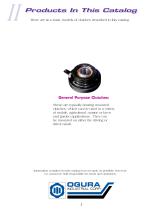
Products In This Catalog Products In This Catalog There are tw o basic models of clutches described in this catalog. General Purpose Clutches: These are typically bearing mounted clutches, which can be used in a variety of mobile, agricultural, marine or lawn and garden applications. They can be mounted on either the driving or driven shaft. Information contained in this catalog is as accurate as possible; however, we cannot be held responsible for errors and omissions.
Open the catalog to page 3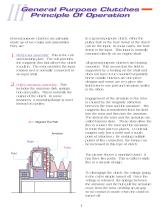
General purpose clutches are primarily made up of two major sub-assemblies. They are: 1 . Field/rotor assembly: This is the coil and backing plate. The coil provides the magnetic flux that allows the clutch to pull in. The rotor provides the input rotation as it is normally connected to an input shaft. 2. Pulley/armature assembly: This includes the armature disk, springs, hub and pulley. This is normally the output of the clutch. In some instances, a mounting flange is used instead of a pulley. ◄- Magnetic Flux Path In a general purpose clutch, either the pulley/hub or the bore (rotor) of...
Open the catalog to page 4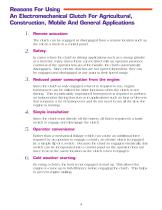
Reasons For Using An Electromechanical Clutch For Agricultural, Construction, Mobile And General Applications Remote actuation: The clutch can be engaged or disengaged from a remote location such as the cab in a truck or a control panel. Safety: In cases where the clutch is driving applications such as a stump grinder or a trencher, many times these can be fitted with an operator presence control so if the operator lets go of the handle, the clutch automatically disengages. Since electric clutches are not speed dependent, they can be engaged and disengaged at any point in their speed range....
Open the catalog to page 5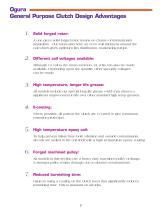
Ogura General Purpose Clutch Design Advantages Solid forged rotor: A one piece solid forged rotor means no chance of internal parts separation. Our rotors also have an even wall thickness around the coil which gives optimum flux distribution, maximizing torque. Different coil voltages available: Although 12 volt is the most common, 24 volts can also be made available. Depending upon the quantity, other specialty voltages can be made. High temperature, longer life grease: All models include our special long life grease which has shown a significant improvement in life over other standard...
Open the catalog to page 6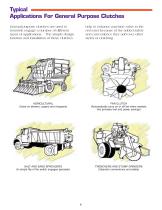
Typical Applications For General Purpose Clutches help to enhance machine value to the end user because of the added safety and convenience they add over other styles of clutching. General purpose clutches are used to remotely engage a number of different types of applications. The simple design function and installation of these clutches AGRICULTURAL (Used on blowers, augers and choppers) FAN CLUTCH (Automatically turns on or off fan when needed; this provides fuel and power savings) SALT AND SAND SPREADERS (A simple flip of the switch engages spreader) TRENCHERS AND STUMP GRINDERS...
Open the catalog to page 7
Ogura General Purpose Clutch Types
Open the catalog to page 8
General Purpose Clutch Dimensions OGURA STATIC CLUTCH BORE KEY VOLTAGE O.D. L A PITCH OVER GAUGE B C D E WEIGHT PART TORQUE TYPE SIZE WAY & WATT Body overall pulley diamater ball ball diameter (lbs) NO. (lb. ft.) (V/W) Diameter length diameter nominal diamater diameter or degree * Taper is standard automotive 1": 4" ratio. Gauge line diameter is .841". Weight is approximate. In non-taper bore clutches, square keys are used. Actual keyway height shown is less. Ogura has many other modified standards available. Contact us if the above clutches do not meet your design requirements.
Open the catalog to page 9
Things to check before installation begins: Engine shaft size: Most of the time, general purpose clutches are mounted directly on the engine shaft. If the installation is not on an engine shaft, please make sure that the tolerances are close enough to provide a snug fit between the bore of our clutch and the shaft. (All engine manufacturers should produce shafts within the required tolerances.) Also, a standard rule of thumb is that the minimum diameter of the shaft for one piece designs is also the minimum amount of shaft engagement. (Two-piece designs would require shaft engagement in...
Open the catalog to page 10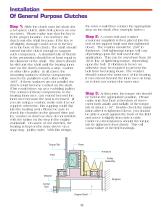
Installation Of General Purpose Clutches Step 1: Slide the clutch onto the shaft, (for the rotor would then contact the appropriate step on the shaft. (See example below.) a two-piece clutch, slide both pieces on one at a time). Please make sure that the key is in the proper location. Do not force the clutch onto the shaft because, if the key is off slightly, damage could occur to the key or to the bore of the clutch. The shaft should extend into the clutch enough to support each component. A standard rule of thumb is the penetration should be at least equal to the diameter of the shaft....
Open the catalog to page 11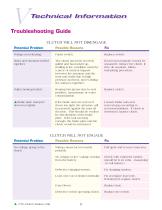
Troubleshooting GuideCLUTCH WILL NOT DISENGAGE Potential Problem Possible Reasons Fix Faulty switch. Replace switch. Rotor and armature locked together. The clutch has been severely galled and has locked up. (Galling is the condition whereby a piece of metal is trapped between the armature and the rotor and melts due to high pressure and heat, spot welding the surfaces together.) If rotor and armature connot be separated, replace the clutch. If they do separate, follow burnishing procedure. Pulley bearing locked. Bearing lost grease due to seal Replace clutch. problem, temperature...
Open the catalog to page 12
If voltage is going to the Coil open or shorted. clutch, but the clutch will still not engage. Check coil with ohmmeter. A range close to 3 to 4 ohms should be present at an ambient coil temperature of 70 F. Replace coil. Clutch engages, but load will not engage. Check coil voltage to make sure it is compatible with the voltage coming in. (If voltage is too high, this could cause the coil to burn out.) Burnt out coil caused by frictional contact (flange mounted clutches, rotor strike). If so, coil will be discolored, can be cracked, burnt or epoxy can be melted. Rotor/armature air gap...
Open the catalog to page 13All OGURA SAS catalogs and technical brochures
-
General_Purpose_Brochure
4 Pages
-
Mobile_Brochure
4 Pages
-
Tension_Control_Brochure
4 Pages
-
Spring_Applied_Brochure
4 Pages
-
Industrial_Brochure
4 Pages
-
Ogura Mobile Clutches
25 Pages
-
Straw Blower PTO
1 Pages
-
Industrial Products brochure
4 Pages
-
Air Pumps
3 Pages
-
Smart Clutch brochure
1 Pages
-
PTO Clutch/Brakes brochure
4 Pages
-
Mobile Clutches brochure
4 Pages
-
Catalog of products
139 Pages
Archived catalogs
-
OGURA Industrial Products
117 Pages




















